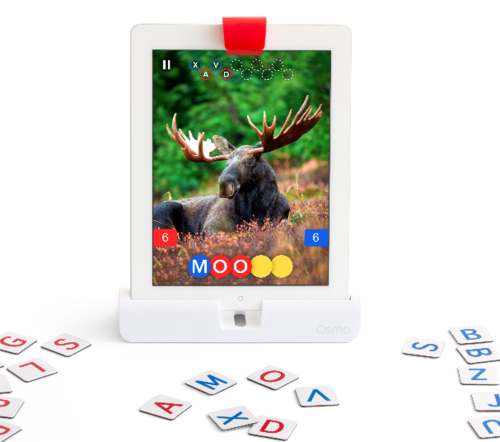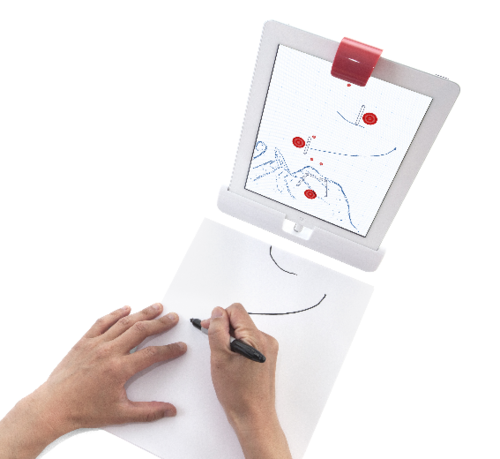It’s the parental lament that just grows louder as kids spend more time glued to a screen: “Why can’t you play with real toys for a change?”
Now the kids can, without having to give up the digital devices they’re so fond of, thanks to Tangible Play’s Osmo. Created by two ex-Googlers and a former Disney executive, Osmo combines real physical objects with the virtual world of an iPad. It uses a simple plastic stand, a mirror, and a handful of common objects to create a unique gaming experience.
Tangible Play’s Osmo lets kids play games on their iPads using pens, paper, and puzzle pieces.
“Instead of a virtual reality game, we wanted to build an ‘actual reality’ game,” says co-founder Pramod Sharma, whose 5-year-old daughter adores her iPad. “We wanted something that didn’t require electronics, WiFi, or a battery, and couldn’t be easily broken. And it needed to be deep. We don’t want you to play it for just a day; we want you to be able to play for months.”
I think they may have succeeded. Osmo is an awesome combination of low-tech toys and high-tech ingenuity. Really, the video above doesn’t do it justice. These games may be aimed at kids age 6 to 12, but once I started playing them, I didn’t want to stop. (What that says about my relative level of emotional maturity is another matter.)
Let’s get physical
Here are the instructions for how to use Osmo. It’s really complicated. Ready?
1. Place your iPad 2 or later into the plastic stand.
2. Hook the mirror over the front-facing camera.
3. Launch the apps.

Osmo will feature three games at launch, each with its own app.
In Words, you compete against another player to spell words using letter tiles written in blue or red. The app displays blank spaces for a three- to seven-letter word, hangman style, along with a photo that offers a clue about the word you’re trying to guess.

You and your opponent toss letters out in front of the iPad as quickly as you can. If the blue player guesses correctly, a blue letter appears in one of the blank spaces. If not, it appears in one of the 10 circles at the top for incorrect guesses. Each letter is worth 2 points, and the words get harder as you advance in the game. Make a lot of mistakes, and the app automatically lowers the difficulty level. The game will launch with a vocabulary of 2,000 words and 200 images.
The second game, Tangram, is based on an ancient geometric puzzle using seven wooden pieces, all with different shapes and colors. The app displays the outlines of a puzzle you must recreate using the pieces. As you place one correctly, the app fills in the puzzle onscreen with the appropriate color. If you get stuck, you can ask Tangram for a hint.

Tangram features more than 2,400 puzzle combinations, and the game isn’t timed or scored in any way. It’s intended to be less competitive and more collaborative, as groups of kids team their talents to solve the trickier puzzles.
The third game, Newton (no relation to the Apple PDA of a previous era), requires two more real-world items: a piece of white paper and a pen. Place the paper directly in front of the iPad and draw a line anywhere on it. Launch the app, and tiny colored balls fall out of an opening onscreen and bounce off the line you just drew, making a musical note as they carom off other objects. Newton has 60 levels, and new objects appear onscreen as you progress.

You can place any object on the paper — pen, keys, glasses, your hand — and the balls will bounce off the outline detected by the camera. As with Tangram, there’s no overarching goal or way to keep score; the play comes from figuring out new ways to use it. For example: You can even take the mirror off the camera and use the outline of your face as an object.
Coming soon to an iPad near you
Besides the games themselves, Osmo is full of other thoughtful design touches. The plastic base and mirror are so sturdy that even the most determined 4-year-old couldn’t break them. Finger-shaped insets and patterns cut into the containers inside each box make it easy to put the pieces back in the right place. The beautifully designed boxes snap shut using a magnetic clasp and are themselves magnetized, so they snap together to sit easily on a bookshelf.
Now for the bad news: At publication time, Osmo was available only for preorder, though if you do it over the next couple of weeks you can get all three games for half off the usual $99 price.
Sharma says that once his company receives 1,000 orders, it will start manufacturing the physical pieces in Asia. After that, you’ll have to wait another eight to 12 weeks for the game to arrive.
Seems like something worth waiting for.

